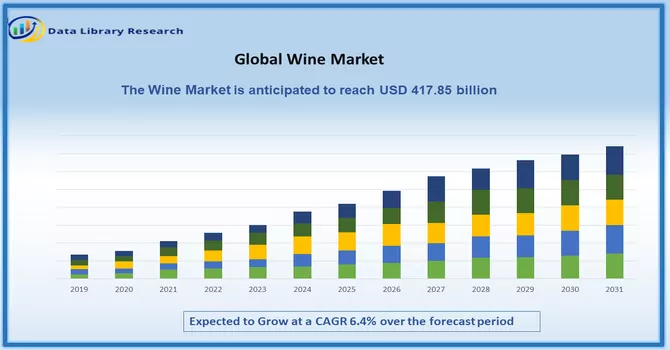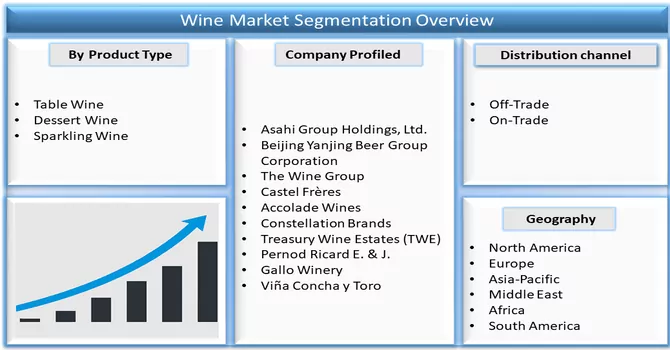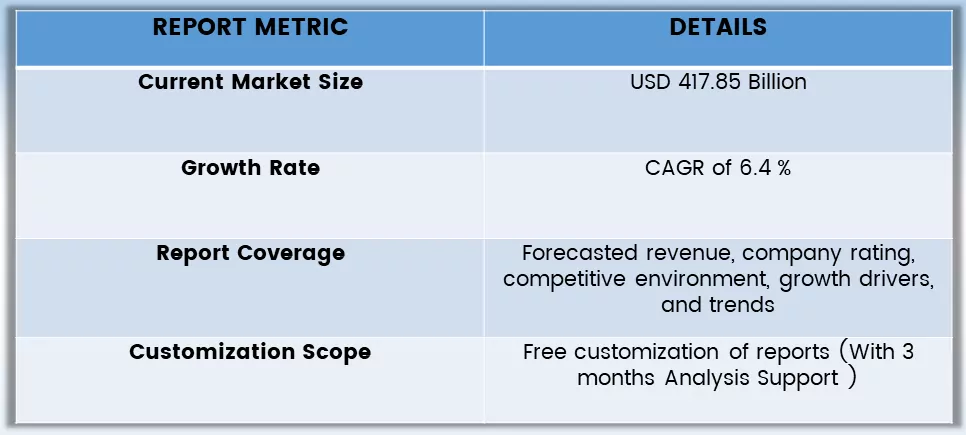The global wine market size was valued at USD 417.85 billion in 2022 and is expected to expand at a compound annual growth rate (CAGR) of 6.4% from 2023 to 2030.

Get Complete Analysis Of The Report- Download Free Sample PDF
Wine is an alcoholic beverage made from the fermentation of grapes or other fruits. The primary ingredient in wine is typically grapes, but it can also be made from other fruits such as apples, cherries, or berries. During the winemaking process, the sugars in the fruit are converted into alcohol and carbon dioxide by yeast through fermentation.
The rising adoption of wine among all age groups from the young generation to the old age population across the globe is the key factor for market growth.
High-quality and premium wines are in demand. Consumers are willing to invest in unique and high-end wine experiences, leading to increased interest in fine wines, rare vintages, and limited production releases. Moreover, the growing interest in wines with reduced alcohol content or completely alcohol-free options, appeals to health-conscious and mindful drinking consumers.
Segmentation:
The Global Wine Market is Segmented
By Product Type :
Distribution Channel :
Geography :

For Detailed Market Segmentation - Download Free Sample PDF
The report offers the market sizes and forecasts in value (USD million) for all the above segments.
Drivers :
Increase in Wine Tourism
Wine tourism not only enriches the travel experiences of visitors but also bolsters the economic vitality of local communities by fostering the growth of wineries, restaurants, and various enterprises within the region. As this trend persists and expands, it is probable that an increasing number of wine-producing areas will channel resources into enhancing their infrastructure and marketing efforts, thereby augmenting their appeal and making wine tourism an increasingly favored and readily accessible option for travelers.
For instance, an article published by Niklas Ridoff in March 2018, reported that since 2015, a new increase in World wine consumption has been noticed. Five countries represent almost half of the wine consumption in the World; the USA, France, Italy, Germany, and China. Inspired by European countries, some countries from the New World involved wine in their lives. China is the fastest-growing wine business.
Moreover, in May 2020 the European Association of Wine Economists and the Chaire Vins et Spiritueux de INSEEC U., reported that the frequency of the consumption of wine has increased significantly during the confinement phase resulting from the outbreak of coronavirus in Spain and the rest of Europe. Thus, the market is expected to witness significant growth over the forecast period.
Increasing Interest in Wine Education
People are increasingly recognizing the depth and diversity of the world of wine. Wine education offers an avenue for individuals to develop a deeper understanding of the various grape varietals, regions, and winemaking techniques. The interest in wine education continues to rise, there is a growing demand for diverse and flexible learning opportunities, including formal courses, workshops, tastings, and self-guided exploration. This trend reflects the evolving appreciation for wine as more than just a beverage. Thus, the market is expected to witness significant growth over the forecast period.
Restraints:
High Cost of Wine Investment
With the impact of high production costs, the overall cost of wine production significantly increases. Additionally, governments and industry organizations may not easily provide grants, subsidies, or initiatives, thus increasing the cost of wine, thereby slowing down the growth of the studied market over the forecast period.
The COVID-19 pandemic brought significant disruptions to the global wine distribution network due to widespread closures and restrictions imposed on hotels and restaurants worldwide. The sudden emergence of the pandemic had a substantial impact on the hospitality industry, with approximately 77% of hotels experiencing a sharp decline in their revenues, plummeting by 60% by the end of 2020. In the case of restaurants, their sales dwindled by a staggering 91% globally during the same period. Simultaneously, there was a notable shift in consumer purchasing patterns. With restaurants, hotels, and bars either closed or operating with limited capacity, consumers turned to alternative avenues for acquiring wine. This led to a surge in wine purchases through food retailers and online platforms. Furthermore, the direct-to-consumer sales channel experienced a notable boost, with specialized wine vendors also noting an increase in their sales volume.
Segmental Analysis:
Sparkling Wine Segment is Expected to Witness Significant growth over the Forecast Period
Sparkling wine is a type of wine that is carbonated, producing effervescence, or bubbles. The bubbles are typically created by either natural fermentation in the bottle (as in the traditional method) or by injecting carbon dioxide under pressure (as in the tank method or carbonation). Sparkling wines are versatile and pair well with a wide range of foods. They are often enjoyed as aperitifs but can also be paired with seafood, poultry, or desserts. Moreover, sparkling wine has cultural significance in many regions, often associated with celebrations and toasts. Thus, the market is expected to witness significant growth over the forecast period.
Off-Trade Distribution Channel Segment is Expected to Witness Significant growth over the Forecast Period
The off-trade wine distribution channel provides consumers with a wide range of options for purchasing wine and is a significant part of the wine industry. It offers convenience, accessibility, and affordability, making it an important avenue for wine producers to reach a broader audience. Thus, the segment is expected to witness significant growth over the forecast period.
North America Region is Expected to Witness Significant growth over the Forecast Period
North America, particularly the United States and Canada, has seen notable growth in wine production and the wine industry over the past several decades.
An article published by Economic Times in June 2023, reported that California is the heart of wine production in the United States, known for its famous wine regions, including Napa Valley and Sonoma County. It is one of the world's largest wine-producing regions and is celebrated for its premium wines. The article also reported that Oregon's Willamette Valley is known for its high-quality Pinot Noir, while other regions in the state produce a variety of wines, including Pinot Gris, Chardonnay, and Riesling and Washington State has gained recognition for its wine production, particularly for its Cabernet Sauvignon, Merlot, and Riesling. Thus, the region is expected to witness significant growth over the forecast period. Moreover, the product launches by the industrial major players are expected to boost the studied market’s growth. For instance, in April 2021, Constellation Brands launched a dedicated business unit for fine wine and craft spirits. The new fine wine and craft spirits include High West Whisky, Casa Noble Tequila, Mi Campo, Copper & Kings, Nelson's Green Brier Distillery, and The Real McCoy. Thus, the region is expected to witness significant growth over the forecast period.

Get Complete Analysis Of The Report- Download Free Sample PDF
Some prominent players in the global wine market include: -
Recent Developments:
1) In July 2020, Constellation Brands acquired Empathy Wines, a direct-to-consumer wine brand, with the aim of winning space on digital shelves.
2) OCT 2022: Treasury Wine Estates Ltd announced the completion of the acquisition of Château Lanessan, one of the oldest estates in Bordeaux, France. The acquisition is the latest step in strengthening Penfold's multi-regional luxury wine portfolio.
Q1. How big is the Wine Market?
The global wine market size was valued at USD 417.85 billion in 2022 and is expected to expand at a compound annual growth rate (CAGR) of 6.4%.
Q2. At what CAGR is the market projected to grow within the forecast period?
Wine Market is expected to expand at a compound annual growth rate (CAGR) of 6.4% over the forecast period.
Q3. Which region has the largest share of the Wine Market? What are the largest region's market size and growth rate?
North America has the largest share of the Wine market . For detailed insights on the largest region's market size and growth rate request a sample here
Q4. What are the factors driving the Wine Market?
Key factors that are driving the growth include the Increase in Wine Tourism and Increasing Interest in Wine Education.
Data Library Research are conducted by industry experts who offer insight on industry structure, market segmentations technology assessment and competitive landscape (CL), and penetration, as well as on emerging trends. Their analysis is based on primary interviews (~ 80%) and secondary research (~ 20%) as well as years of professional expertise in their respective industries. Adding to this, by analysing historical trends and current market positions, our analysts predict where the market will be headed for the next five years. Furthermore, the varying trends of segment & categories geographically presented are also studied and the estimated based on the primary & secondary research.
In this particular report from the supply side Data Library Research has conducted primary surveys (interviews) with the key level executives (VP, CEO’s, Marketing Director, Business Development Manager and SOFT) of the companies that active & prominent as well as the midsized organization
FIGURE 1: DLR RESEARH PROCESS

Extensive primary research was conducted to gain a deeper insight of the market and industry performance. The analysis is based on both primary and secondary research as well as years of professional expertise in the respective industries.
In addition to analysing current and historical trends, our analysts predict where the market is headed over the next five years.
It varies by segment for these categories geographically presented in the list of market tables. Speaking about this particular report we have conducted primary surveys (interviews) with the key level executives (VP, CEO’s, Marketing Director, Business Development Manager and many more) of the major players active in the market.
Secondary ResearchSecondary research was mainly used to collect and identify information useful for the extensive, technical, market-oriented, and Friend’s study of the Global Extra Neutral Alcohol. It was also used to obtain key information about major players, market classification and segmentation according to the industry trends, geographical markets, and developments related to the market and technology perspectives. For this study, analysts have gathered information from various credible sources, such as annual reports, sec filings, journals, white papers, SOFT presentations, and company web sites.
Market Size EstimationBoth, top-down and bottom-up approaches were used to estimate and validate the size of the Global market and to estimate the size of various other dependent submarkets in the overall Extra Neutral Alcohol. The key players in the market were identified through secondary research and their market contributions in the respective geographies were determined through primary and secondary research.
Forecast Model
